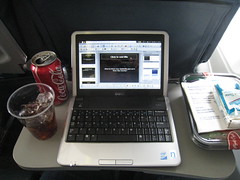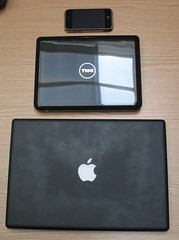I’d like to share some exciting news with you all… After four awesome years working for the Wikimedia Foundation full-time, next month I’m going to be starting a new position at StatusNet, leading development on the open-source microblogging system which powers identi.ca and other sites.
I’ve been contributing to StatusNet (formerly Laconica) as a user, bug reporter, and patch submitter since 2008, and I’m really excited at the opportunity to get more involved in the project at this key time as we gear up for a 1.0 release, hosted services, and support offerings.
StatusNet was born in the same free-culture and free-software community that brought me to Wikipedia; many of you probably already know founder Evan Prodromou from his longtime work in the wiki community, launching the awesome Wikitravel and helping out with MediaWiki development on various fronts. The “big idea” driving StatusNet is rebalancing power in the modern social web — pushing data portability and open protocols to protect your autonomy from siloed proprietary services… People need the ability to control their own presence on the web instead of hoping Facebook or Twitter always treat you the way you want.
This does unfortunately mean that I’ll have less time for MediaWiki as I’ll be leaving my position as Wikimedia CTO sooner than originally anticipated, but that doesn’t mean I’m leaving the Wikimedia community or MediaWiki development!
Just as I was in the MediaWiki development community before Wikimedia hired me, you’ll all see me in the same IRC channels and on the same mailing lists… I know this is also a busy time with our fundraiser coming up and lots of cool ongoing developments, so to help ease the transition I’ve worked out a commitment to come into the WMF office one day a week through the end of December to make sure all our tech staff has a chance to pick my brain as we smooth out the code review processes and make sure things are as well documented as I like to think they are. ;)
We’ve got a great tech team here at Wikimedia, and we’ve done so much with so little over the last few years. A lot of really good work is going on now, modernizing both our infrastructure and our user interface… I have every confidence that Wikipedia and friends will continue to thrive!
I’ll start full-time at StatusNet on October 12. My key priorities until then are getting some of our key software rollouts going, supporting the Usability Initiative’s next scheduled update and getting a useful but minimally-disruptive Flagged Revisions configuration going on English Wikipedia. I’m also hoping to make further improvements to our code review process, based on my experience with our recent big updates as well as the git-based workflow we’re using at StatusNet — I’ve got a lot of great ideas for improving the CodeReview extension…
Erik Moeller will be the primary point of contact for WMF tech management issues starting October 12, until the new CTO is hired. I’ll support the hiring process as much as I can, and we’re hoping to have a candidate in the door by the end of the year.
— brion vibber (brion @ wikimedia.org)
CTO, Wikimedia Foundation
San Francisco
Update: Evan’s announce is up on the StatusNet blog.





